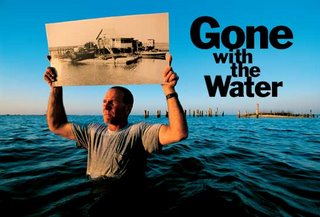
Hurricane Katrina Reading List.
Here are some books and articles to check out if you want to learn more about what happened to the Gulf Coast and New Orleans last August, or about hurricanes in general. (Remember also that additional articles from the New Orleans and Gulport/Biloxi newspapers are available as well in the "Links" section of this blog.)
The Storm, by Ivor van Heerden and Mike Bryan (Viking; May 2006).
The subtitle of this book is "What Went Wrong and Why During Hurricane Katrina - The Inside Story from One Louisiana Scientist." Although this book is focused more on the impact of Katrina on the City of New Orleans -- van Heerden is a professor at Louisiana State University, and director of the LSU Hurricane Center and director of the Center for the Study of Public Health Impacts of Hurricanes, so New Orleans is of particular interest to him and his team of scientists and graduate students -- it is excellent if you are interested in the science behind Katrina: of hurricanes; of the impact of wetlands (and the loss thereof) on increased storm surges; of the impact of man-made facilities like shipping canals and oil and gas pipelines on wetlands and marsh subsidence; and, of post-catastrophe health issues ("toxic sludge") and forensics (what caused the Industrial and 17th Street Canal levee walls to fail?). The downside of the book is that Professor van Heerden can come across as a bit strident and opinionated. Nevertheless, this book makes a compelling case for the argument that the Federal effort to protect New Orleans has not accounted for some of the lastest science and engineering advances (especially those pioneered by the Dutch). Perhaps more disturbing is the notion that, at landfall, Katrina was not "The Big One," at least as far as New Orleans is concerned. Failure to improve the existing system of levees and other protections prior to a direct hit on New Orleans could have even more devastating consequences.
The Great Deluge: Hurricane Katrina, New Orleans, and the Mississippi Gulf Coast, by Douglas Brinkley (William Morrow; May 2006).
This is a fairly exhaustive narrative history of the events before, during, and after Katrina, especially in New Orleans (Brinkley is a professor of history at Tulane University), but with coverage also of the storm's impact on the Mississippi Gulf Coast. At over 600 pages, this is not a quick read, but this is a good book especially if you want to get immersed in the details surrounding the Federal and state/local government responses to Katrina. A minor beef is the fact that, unlike van Heerden's The Storm, Brinkley's book has no maps, which would be helpful in keeping straight the location of certains towns along the Gulf Coast and the various neighborhoods within New Orleans.
Issac's Storm: A Man, A Time, and The Deadliest Hurricane in History, by Erik Larson (Vintage; July 2000).
Larson's book was a bestseller several summers ago. It is a harrowing description of the September 8, 1900 storm (hurricanes were unnamed at that time) that slammed into Galveston, Texas. Between the storm's tidal surge and the Category 5-level winds, thousands of buildings were completely destroyed, entire sections of the coastal city disappeared, and an estimated 8,000-10,000 people were killed. The effects (physical and psychological) were so profound that Texans effectively abandoned Galveston for what was at that time the much smaller (and further inland) city of Houston.
Through The Eye of The Storm, by Choleen Espinoza (Chelsea Green Publishing Company; May 2006).
This is a book specifically dedicated to describing what the rebuilding effort has been like in one Gulf Coast community, De Lisle, which is 5 miles north up W. Wittman Road from Pass Christian. All proceeds from the sale of the book are earmarked for the construction of a Pass Christian/De Lisle Community Center, which will provide educational and recreational opportunities for the children of these communities who are still trying to live a life in the wake of the havoc caused by the storm. (Incidentally, $360,000 toward a $1M goal have been raised thus far from sales of the book and other contributions and sources.)
Ms. Espinoza is an Air Force Academy graduate who flew U2 spy plane missions, has done a stint as an embedded journalist during the most recent Iraq conflict, and is captain of commercial airline flights for American Airlines.
Probably no other book describes in as much detail what is going on now that the adrenaline rush of the catastrophe has subsided. This book clearly documents the fact that individual and faith-based volunteer groups are providing the lion's share of the relief on the Gulf Coast, in the vacuum created by the lack of full engagement of the Federal government and the insurance companies.
It may also be the rare book where an individual living an alternative lifestyle makes liberal and highly effective use of quotations from both the Old and New Testaments, so this could make for an interesting (or confounding, depending on your perspective) read on more than one level.
National Geographic - October 2004: "The Incredible Shrinking Bayou," by Joel K. Bourne, Jr.
From the article's intro: "Louisiana's wetlands are twice the size of Everglades National Park, funnel more oil into the United States than the Alaska pipeline, sustain one of the nation's largest fisheries, and provide vital hurricane protection for New Orleans. And they're disappearing under the Gulf of Mexico at the rate of 33 football fields a day." A prophetic article in relation to the warnings of the potential dangers of wetlands loss in relation to reduced hurricane protection for New Orleans, especially given Katrina's arrival less than 12 months after this story was published.


0 Comments:
Post a Comment
<< Home